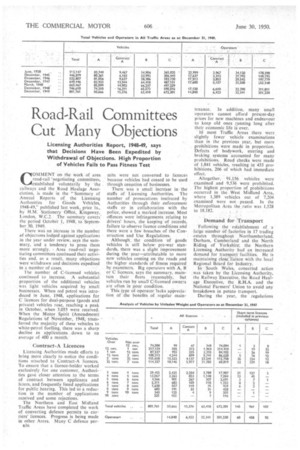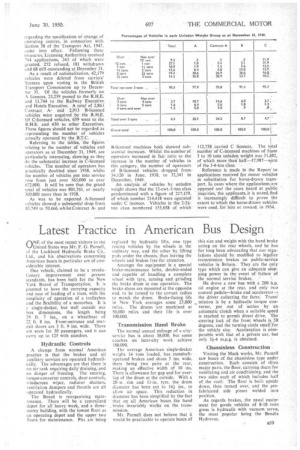Road-Rail Committees Cut Many Objections
Page 78

Page 81

If you've noticed an error in this article please click here to report it so we can fix it.
Licensing Authorities Report, 1948-49, says that Decisions Have Been Expedited by Withdrawal of Objections. High Proportion of Vehicles Fails to Pass Fitness Test
COMMENT On the work of area road-rail *negotiating committees, .. established voluntarily by 'the . railways and the Road Haulage Association, is made in the "Summary of Annual Reports of . the Licensing Authorities for Goods Vehicles, 1948-49." published last week, price Is., by 1-1.K Stationery Office, Kingsway, London, W.C.2. The summary covers' the period Octobef 1, 1948, to September 30, 1949.
There was an increase in the number of objections lodged against applications in the year under review, says the summary, and a tendency to press them more strongly. , Area road-rail negotiating committees continued their activities and, as a result, many objections were withdrawn and decisions exPedited in a number of cases.
The number of C-licensed vehicles, continued to increase. A substantial proportion of the additional vehicles was light vehicles acquired by small businesses. When red petrol was introduced in June, 1948, applications for C licences for dual-purpose (goods and private) vehicles rose, reaching a peak in October, when 5,055 were received. When the Motor Spirit (Amendment) Regulations 'of. November, 1948; transferred the majority of these vehicles to white-petrol fuelling, there was a sharp decline in ajcplications down to an average of 400 a month.
Contract-A Licences
Licensing Authorities made efforts to bring more clearly to notice the conditions attached to Contract-A licences. To ensure that a licence-holder worked exclusively for one customer, Authorities gave closer attention to the terms of contract between applicants and hirers, and frequently listed applications for public hearing_ This led to a reduction in the number of applications received and some rejections. , The Northern and East Midland Traffic Areas have completed the work of converting defence permits to carriers' licences. Progress is being made in other Areas. Many C defence per.
a36 mits were not converted to licences because vehicles had ceased to be used through cessation of businesses. There was a small increase in. the staffs of Licensing Authorities. The number of prosecutions instituted by Authorities through their enforcement staffs or in collaboration with the police, showed a marked increase. Most offences were infringements relating to drivers' hours, the keeping of records, failure to observe licence conditions and there were a few breaches of the Construction and Use Regulations.
Although:.. the condition 'of goods vehicles is still below pre-war standards, there was a slight improvement during the year,-attributable to more new vehicles coming on the roads and the higher standards of fitness required by examiners. Big operators with A, B or C licences, says the summary, maintain their fleets reasonably, but vehicles-fun by small C:licensed owners are often in poor condition.
This type of operator 'lacks appreciation of the benefits of regular main
tenance. In addition, many small operators cannot afford present-day prices for new machines and endeavour to keep old ones running long after their economic life is over.
'hi most Traffic Areas there were slightly fewer vehicle examinations than in the previous year, but more prohibitions were made in proportion. Defects of bodywork, steering and braking systems accounted for many prohibitions. Road checks were made of 1,841 vehicles, resulting in 455 prohibitions, 206 of which had immediate
effect.
Altogether, 91,156. vehicles were examined and 9,536 were prohibited. The highest proportion of prohibitions occurred in the West Midland Area, where 1,389 vehicles out of 7,204 examined were not passed. In the Metropolitan Area the ratio was 1,528 to 18,182.
Demand for Transport • Following the establishment of a large number of-factories in 17 trading estates throughout Northumberland. Durham, Cumberland and the North Riding of Yorkshire: the Northern . Licensing Authority had an increased demand for transport facilities. He is maintaining ,closeliaiion with the local Regional Board for Industry.
In -South Wales, concerted action was taken by the Licensing Authority, the Railway Executive. the Road Haulage Executive, the R.H.A. and the National Farmers' Union to avoid any breakdown in potato transport.
During the year, the regulations
legarding the specification or change of operating centres, in connection with Section 58 of the Transport Act, 1947. came into effect. Following these measures, Licensing Authorities received 764 applications, 243 of which were granted, 272 refused, 181 withdrawn and 68 still outstanding at December 31.
As a result of nationalization, 42,179 vehicles were deleted from carriers' licences upon vesting in the British Transport Commission up to December 31. Of the vehicles formerly on A licences, 23,259 passed to the R.H.E. and 11,744 to the Railway Executive and Hotels Executive. A total of 2,863 Contract Aand 2,913 B-licensed vehicles were acquired by the R.H.E. Of C-licensed vehicles, 659 went to the R.H.E. and 650 to other Executives. These figures should not be regarded as representing the number of vehicles actually operated by the B.T.C. Referring to the tables, the figures relating to the number of vehicles and operators as at December 31, 1949, are particularly interesting, showing as they do the substantial increase in C-licensed vehicles. The numbei of operators has practically doubled since 1938, whilst the number of vehicles put into service rose from just over 365,000 to over 672,000. It will be seen that the grand total of vehicles was 801,761, or nearly 300.000 more than in 1938.
As was to be expected A-licensed vehicles showed a substantial drop from 83,749 to 50.666, whilst Contract Aand B-licensed machines both showed substantial increases. Whilst the number of operators increased in fair ratio to the increase in the number of vehicles in this category, the number of operators of B-licensed vehicles dropped from 34,120 in June, 1938, to 32,341 in December. 1949.
An analysis of vehicles by unladen weight shows that the 12-cwt.-1-ton.class predominated with a figure of 217,159, of which number 214,418 were operated under C licences. Vehicles in the2-2+ton class numbered 155,658 of which
112,758 carried C licences. The tOtal number of C-licensed machines of fipm 3 to 10 tons unladen weight was 31,482, of which more than half-17,987-were of the 3-4-ton class.
Reference is made in the Report' to applications received for motor vehicles in substitution for horse-drawn traAtsport. In cases where the applications.bre opposed and the cases heard at public inquiries, the applicants, it is stated, find it increasingly difficult to prove the extent to which the horse-drawn vehicles were used, for hire or reward, in 1934.




























































































































